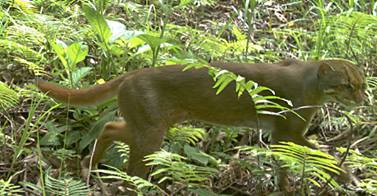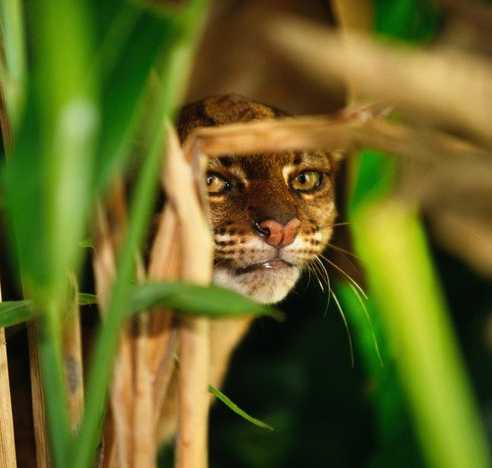
One of the world’s least-known and most endangered wild cats, the bay cat, has been photographed by Panthera grantees Jedediah Brodie (Universiti Malaysia Sabah/ University of British Columbia) and Anthony Giordano (S.P.E.C.I.E.S/Texas Tech University). Their photograph is the first record of this very elusive cat in the Borneo highlands, at 1460 meters (approximately 4,800 feet).
The records add to our very limited knowledge of the species, which was photographed alive for the first time only in 1998 and where most previous records are from dense lowland forest under 800 meters (approximately 2,600 feet).
Borneo’s bay cat is so elusive that it took over a century before researchers got a chance to study a live one in detail. Covered in striking, rust-red fur with white under the tail and face stripes, this cat was officially named in 1874 on the basis of a skull and torn skin sent to England by the famous naturalist Alfred Russel Wallace. Naturalists didn’t have a chance to study a live one until a bay cat was captured in 1992, and the cat remains so difficult to find that researchers know very little about how this secretive cat actually lives. The fact that the cat is so difficult to find is all the more frustrating because conservationists list the felid as endangered. The deforestation of Borneo may wipe out the bay cat before scientists get a chance to find out more about it.
The Elusive Bay Cat Confirmed in Borneo’s Highlands
 One of the world’s least-known and most endangered wild cats, the bay cat, has been photographed by Panthera grantees Jedediah Brodie (Universiti Malaysia Sabah/ University of British Columbia) and Anthony Giordano (S.P.E.C.I.E.S / Texas Tech University). Their photograph is the first record of this very elusive cat in the Borneo highlands, at 1460 meters (approximately 4,800 feet). The records add to our very limited knowledge of the species, which was photographed alive for the first time only in 1998 and where most previous records are from dense lowland forest under 800 meters (approximately 2,600 feet).
One of the world’s least-known and most endangered wild cats, the bay cat, has been photographed by Panthera grantees Jedediah Brodie (Universiti Malaysia Sabah/ University of British Columbia) and Anthony Giordano (S.P.E.C.I.E.S / Texas Tech University). Their photograph is the first record of this very elusive cat in the Borneo highlands, at 1460 meters (approximately 4,800 feet). The records add to our very limited knowledge of the species, which was photographed alive for the first time only in 1998 and where most previous records are from dense lowland forest under 800 meters (approximately 2,600 feet).
The bay cat only occurs on the island of Borneo (which comprises three countries, Brunei, Indonesia and Malaysia). Around the size of a large domestic cat, the bay cat has two distinct color phases, rich, rusty-red and grey with red undertones. Until recently, the species has never been the focus of intensive scientific research. Brodie’s and Giordano’s work is part of Panthera’s commitment to initiate and support research into the world’s least known cat species. Panthera also cooperates with Oxford University’s WildCRU on a project led by Andrew Hearn and David Macdonald which has photographed the bay cat on 28 occasions, perhaps the largest number of records in existence. Hearn and collaborator Joanna Ross were also the first to film the species with a video camera trap in 2007.
Map of Bay Cat Range and Protected Areas
The new photographs are the first record of the bay cat for the recently established Pulong Tau National Park within Malaysian Borneo’s Kelabit Highlands. The camera traps also revealed a stunning wealth of other wildlife, including the Sunda clouded leopard, marbled cat, banded civet and sun bear, all of which are listed as Vulnerable on the International Union for the Conservation of Nature’s Red List of Threatened Species.
Brodie explained that “We’ve never known conclusively whether the bay cat occurred at this high an elevation. Our record is an important contribution to existing knowledge of this unique and elusive species, and to this amazing ecosystem.” Giordano added that “Although Borneo’s lowland forests are without question a primary regional conservation concern, we are only beginning to learn the wealth of biodiversity that these highland regions harbor. The fact that we now know the bay cat occurs here could change the way we approach future efforts to locate it.”
Despite the elevation and remoteness of Borneo’s Kelabit Highlands, the biodiversity of this region remains threatened by both legal and illegal logging for palm oil plantations and other developments, and Pulong Tau National Park is a region that is really only protected ‘on paper’. As Brodie explained, “This is a ‘paper park’ for sure, currently with no budget, no infrastructure, and no staff, including no park rangers. Given that we have recorded such a rich mammal fauna, we urgently need to see that it receives the additional scientific attention and protection it deserves.”
Read a Mongabay article on this discovery – Borneo’s most elusive feline photographed at unexpected elevation.
Watch a camera trap video of the Bornean bay cat.
For more information on Panthera’s grant programs supporting projects on little known cats like the bat cay, see Panthera’s Small Cat Action Fund.
Source: Pantera.org





